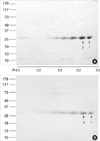1. Park HS, Kim MJ, Moon HB. Occupational asthma caused by two herb materials, Dioscorea batatas and Pinellia ternata. Clin Exp Allergy. 1994. 24:575–581.

2. Lee SK, Cho HK, Cho SH, Kim SS, Nahm DH, Park HS. Occupational asthma and rhinitis caused by multiple herbal agents in a pharmacist. Ann Allergy Asthma Immunol. 2001. 86:469–474.

3. Lee JY, Lee YD, Bahn JW, Park HS. A case of occupational asthma and rhinitis caused by Sanyak and Korean ginseng dusts. Allergy. 2006. 61:392–393.

4. Kim SH, Jeong H, Kim YK, Cho SH, Min KU, Kim YY. IgE-mediated occupational asthma induced by herbal medicine, Banha (Pinellia ternata). Clin Exp Allergy. 2001. 31:779–781.

5. Crapo RO, Casaburi R, Coates AL, Enright PL, Hankinson JL, Irvin CG, MacIntyre NR, McKay RT, Wanger JS, Anderson SD, Cockcroft DW, Fish JE, Sterk PJ. Guidelines for methacholine and exercise challenge testing-1999. This official statement of the American Thoracic Society was adopted by the ATS Board of Directors, July 1999. Am J Respir Crit Care Med. 2000. 161:309–329.
6. Kim SH, Kim HM, Ye YM, Kim SH, Nahm DH, Park HS, Ryu SR, Lee BO. Evaluating the allergic risk of genetically modified soybean. Yonsei Med J. 2006. 47:505–512.

7. Shewry PR. Tuber storage proteins. Ann Bot (Lond). 2003. 91:755–769.

8. Hou WC, Lee MH, Chen HJ, Liang WL, Han CH, Liu YW, Lin YH. Antioxidant activities of dioscorin, the storage protein of yam (Dioscorea batatas Decne) tuber. J Agric Food Chem. 2001. 49:4956–4960.
9. Hou WC, Hsu FL, Lee MH. Yam (Dioscorea batatas) tuber mucilage exhibited antioxidant activities in vitro. Planta Med. 2002. 68:1072–1076.
10. Lee CL, Wang JJ, Kuo SL, Pan TM. Monascus fermentation of dioscorea for increasing the production of cholesterol-lowering agent-monacolin K and antiinflammation agent--monascin. Appl Microbiol Biotechnol. 2006. 72:1254–1262.

11. Oh MH, Houghton PJ, Whang WK, Cho JH. Screening of Korean herbal medicines used to improve cognitive function for anti-cholinesterase activity. Phytomedicine. 2004. 11:544–548.

12. Cartier A, Malo JL, Pineau L, Dolovich J. Occupational asthma due to pepsin. J Allergy Clin Immunol. 1984. 73:574–577.

13. Subiza J, Subiza JL, Escribano PM, Hinojosa M, Garcia R, Jerez M, Subiza E. Occupational asthma caused by Brazil ginseng dust. J Allergy Clin Immunol. 1991. 88:731–736.

14. Moneret-Vautrin DA, Kanny G, Lagrange A. Occupational asthma caused by organic substances. Rev Med Interne. 1994. 15:Suppl 2. 216s–225s.
15. Golec M, Skorska C, Mackiewicz B, Gora A, Dutkiewicz J. Respiratory effects of exposure to dust from herbs. Ann Agric Environ Med. 2005. 12:5–10.
16. Aalberse RC, Van Milligen F, Tan KY, Stapel SO. Allergen-specific IgG4 in atopic disease. Allergy. 1993. 48:559–569.

17. Tiikkainen U, Klockars M. Clinical significance of IgG subclass antibodies to wheat flour antigens in bakers. Allergy. 1990. 45:497–504.

18. Park HS, Suh CH, Nahm DH, Kim HY. Presence of specific IgG antibody to grain dust does not go with respiratory symptoms. J Korean Med Sci. 1999. 14:39–44.

19. Gaidamashvili M, Ohizumi Y, Iijima S, Takayama T, Ogawa T, Muramoto K. Characterization of the yam tuber storage proteins from Dioscorea batatas exhibiting unique lectin activities. J Biol Chem. 2004. 279:26028–26035.

20. Harvey PJ, Boulter D. Isolation and characterization of the storage protein of yam tubers (Dioscorea rotundata). Phytochemistry. 1983. 22:1687–1693.

21. Hou WC, Liu JS, Chen HJ, Chen TE, Chang CF, Lin YH. Dioscorin, the major tuber storage protein of yam (Dioscorea batatas decne) with carbonic anhydrase and trypsin inhibitor activities. J Agric Food Chem. 1999. 47:2168–2172.







 PDF
PDF ePub
ePub Citation
Citation Print
Print





 XML Download
XML Download